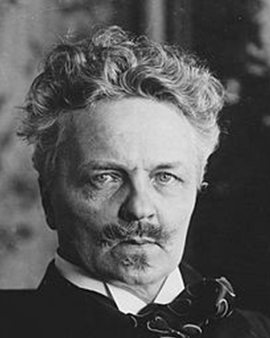In the early 1990s, the auction of his painting "Inferno" by the London auction house Christie's brought in 1.2 million pounds. In the accompanying catalog, August Johan Strindberg was even described as "one of the most important painters of his time". Nevertheless, the Swede is better known today as a writer than as a painter. He is especially famous for his dramas, of which he wrote no fewer than 60. Among his most important works are probably "Miss Julie" and "The Dance of Death".
As the fourth of eight children of the steamship commissionaire Carl Oscar Strindberg, the young August Johan enjoyed a good education. His artistic interest, however, was awakened only later. During his medical studies, which he never completed for financial reasons, he began writing and became a journalist and editor. Eventually he got a job as a secretary at the Royal Library. It was also during this time that he began his satirical social novel "The Red Room," which was to be his breakthrough and lay the foundation for his great literary career. When he died of stomach cancer in 1912, he enjoyed such a high profile that the funeral procession included 60,000 people.
But also as a painter Strindberg just set clear traces in art history - even if not yet in his lifetime. Rather, at that time, his works met with incomprehension, even sharp criticism, even among his artist friends. That didn't stop Strindberg from living it up both on the canvas and behind the camera. After the failure of his marriage to the journalist Frida Uhl, already his second wife after Siri on Essen, the artist went through a phase in which he suffered from depression and delusions. He also coped very badly psychologically with the separation from his third wife Harriet Bosse. The writer claimed in an essay that painting was only a leisure activity for him. However, painting probably helped him to organize his thoughts and to come to terms with his sometimes psychotic experiences. Especially when he was again affected by a writer's block, he painted himself free. For this reason alone, Strindberg's paintings are closely linked to his literary work. It is dramatic landscapes that characterize his early paintings in particular and correspond with his "Inferno" phase as a writer. To capture rocks and water, the artist often used a spatula to apply paint, which usually dissolved the figurative. He mixed the colors himself only on the canvas. As a result, his paintings such as "Golgotha, Dornach" or "Seestück mit Felsen" seem unfinished to the viewer. After the turn of the century and in a much brighter state of mind, August Johan Strindberg then created more hopeful, almost cheerful pictures reminiscent of dream worlds. However, the sea and the sky were to remain his main themes even in these symbol-laden and expressionistic works. August Johan Strindberg's paintings are represented today in the permanent collection of the Swedish National Museum, among others.
×





.jpg)
.jpg)
.jpg)
.jpg)
.jpg)
.jpg)
 - (MeisterDrucke-1246).jpg)
 - (MeisterDrucke-1246).jpg)
_-_(MeisterDrucke-977225).jpg)
_-_(MeisterDrucke-977225).jpg)
_-_(MeisterDrucke-1657011).jpg)
_-_(MeisterDrucke-1657011).jpg)
.jpg)
.jpg)
.jpg)
.jpg)
_-_(MeisterDrucke-1658744).jpg)
_-_(MeisterDrucke-1658744).jpg)
_Ec_Sued_-_(MeisterDrucke-982646).jpg)
_Ec_Sued_-_(MeisterDrucke-982646).jpg)
.jpg)
.jpg)
_-_(MeisterDrucke-1658656).jpg)
_-_(MeisterDrucke-1658656).jpg)
_-_Little_Water_Dalaroe_by_Strindberg_Augu_-_(MeisterDrucke-1010791).jpg)
_-_Little_Water_Dalaroe_by_Strindberg_Augu_-_(MeisterDrucke-1010791).jpg)
.jpg)
.jpg)
.jpg)
.jpg)
.jpg)
.jpg)
_-_(MeisterDrucke-1114550).jpg)
_-_(MeisterDrucke-1114550).jpg)
.jpg)
.jpg)
.jpg)
.jpg)
_-_(MeisterDrucke-384083).jpg)
_-_(MeisterDrucke-384083).jpg)
_-_(MeisterDrucke-899342).jpg)
_-_(MeisterDrucke-899342).jpg)
.jpg)
.jpg)
.jpg)
.jpg)
_-_1903_-_Oil_on_canvas_-_945_-_(MeisterDrucke-939303).jpg)
_-_1903_-_Oil_on_canvas_-_945_-_(MeisterDrucke-939303).jpg)
.jpg)
.jpg)
.jpg)
.jpg)
.jpg)
.jpg)
.jpg)
.jpg)
.jpg)
.jpg)
.jpg)
.jpg)
.jpg)
.jpg)






